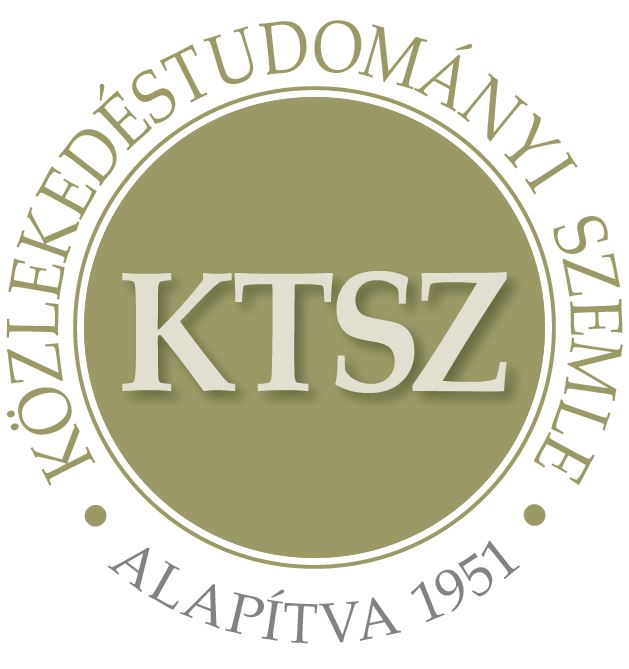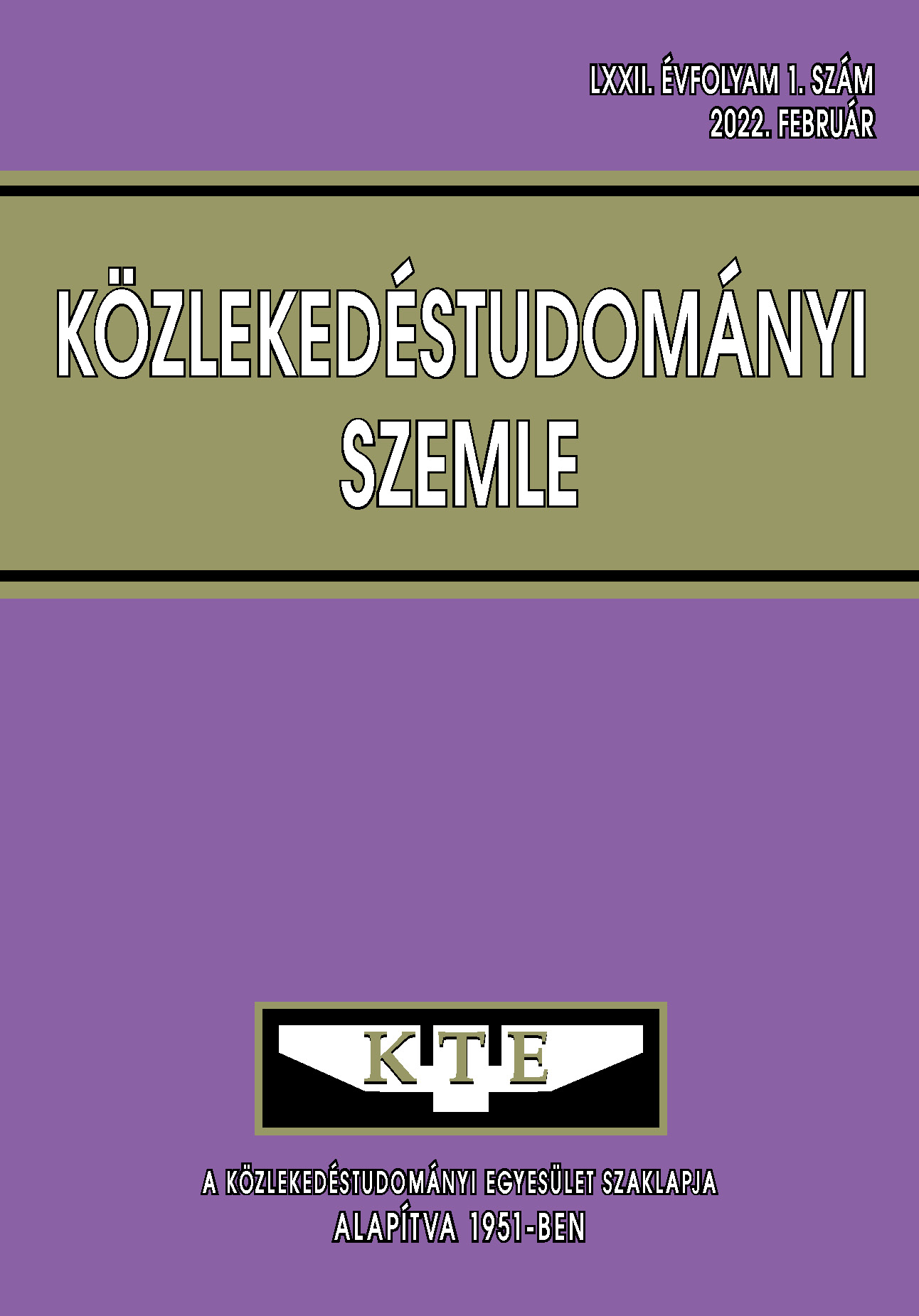Railway infrastructure investment planning taking into account critical infrastructure protection aspects
Abstract
High-value rail infrastructure investments have a lifespan of several decades. During this time, they need to be protected from the effects that could hinder their operation. The design of the protection needs to be started as early as the design of the facilities, as this will reduce installation costs and barriers. The article presents a set of criteria for the development
of protection planning, which is based on our research on the possibilities of the protection of critical transport infrastructures.
References
Bognár Balázs – Bonnyai Tünde (szerk.): Kritikus Infrastruktúrák védelme I., Dialóg Campus Kiadó, Budapest, 2019
Pederson, P. – Dudenhoeffer, D. – Hartley, S. – Permann, M.: Critical Infrastructure Interdependency Modeling: A
Survey of U.S. and International Research, Idaho National Laboratory, Idaho Falls, Idaho, U.S., 2006
Petit, F. et al.: Analysis of Critical Infrastructure Dependencies and Interdependencies, Argonne National Laboratory, Argonne, Illinois, U.S., 2015 DOI: https://doi.org/hb43
Horváth Attila: A kritikus infrastruktúra védelem komplex értelmezésének szükségessége. In Horváth Attila (szerk.): Fejezetek a kritikus infrastruktúra védelemből. Kiemelten a közlekedési alrendszer. Magyar Hadtudományi Társaság, Budapest, 2013, pp. 18-37.
Martin, H. – Ludek, L.: Conceptual design of the resilience evaluation system of critical infrastructure elements and networks in selected areas in Czech republic, 2012 IEEE Conference on Technologies for Homeland Security (HST), 2012, pp. 353-358, DOI: https://doi.org/hb44
Horváth Attila: Szempontok a katonai közlekedési rendszer védelemigazgatási és nemzetgazdasági kapcsolatrendszeréről, Hadmérnök, 24:különszám, 2016, pp. 245-266.
Horváth Attila: Az ellátási lánc, mint kritikus infrastruktúra (létfontosságú rendszerelem), In: Humánvédelem – békeműveleti és veszélyhelyzet-kezelési eljárások fejlesztése (Tanulmánygyűjtemény I. e-book), Nemzeti Közszolgálati Egyetem, Budapest, 2016
Chikán Attila: Vállalatgazdaságtan, Aula Kiadó, Budapest, 1999
Rail Cargo Hungária Zrt.: 1. sz. Kézikönyv: Áruforgalomra megnyitott állomások listája 2019. 12. 15.
PricewaterhouseCoopers: Transportation & Logistics 2030 Volume 4: Securing the supply chain, 2011
Witowski, K.: Internet of Things, Big Data, Industry 4.0 – Innovative Solutions in Logistics and Supply Chains Management, Procedia Engineering 182, 2017, pp. 763-769. DOI: https://doi.org/ghtc3g
Domboróczky Zoltán: Ellátási láncok és logisztikai szolgáltatások biztonsági aspektusai, In: Horváth Attila - Bányász Péter (szerk.): Fejezetek a kritikus infrastruktúra védelemből I. Kiemelten a közlekedési alrendszer (Tanulmánykötet), Magyar Hadtudományi Társaság, Budapest, 2013, pp. 226-237.
Ronyecz Lilla: Létfontosságú rendszerek és létesítmények védelmével kapcsolatos kockázatelemzési módszertan szakirodalmának bemutatása, Védelem Tudomány, 3:3, 2018, pp. 112-132.
Szászi Gábor: A vasúti hálózati infrastruktúrával szemben támasztott újszerű védelmi követelmények kutatása, a továbbfejlesztés feltételrendszerének vizsgálata, Doktori (PhD) értekezés; Nemzeti Közszolgálati Egyetem, Budapest, 2013.
Leitner, B. – Môcová L. – Hromada M.: A new Approach to Identification of Critical Elements in Railway Infrastructure, Procedia Engineering 187, 2017, pp. 143-149. DOI: https://doi.org/hb45
Az Európai Unió Tanácsának 2008/114/EK irányelve az európai kritikus infrastruktúrák azonosításáról és kijelöléséről, valamint védelmük javítása szükségességének értékeléséről, https://eur-lex.europa.eu/ legalcontent/HU/TXT/PDF/?uri=CELEX:32008L0114&from=NL (letöltve: 2021. 11. 16.)
Capra, G. S.: Protecting Critical Rail Infrastructure, Counterproliferation Paper No. 38, USAF Counterproliferation Center, Air Academy, Maxwell Air Force Base, Alabama, U.S., 2006
Horváth Attila: Közlekedési hálózat és az ország védelmi képesség kapcsolata (védelmi követelmények a közlekedésfejlesztésben), Biztonságpolitika, biztonságpolitikai szakportál, 2009, pp. 1-9.
Venekei József – Szajkó Gyula: Magyarország lehetséges szerepe a NATO RSOMműveleteiben, Hadtudományi Szemle, 13:4, 2020, pp. 23-40.
Tóth Bálint – Helmeczi Gusztáv: Védelmi követelmények a Gazdasági és Közlekedési Minisztérium közlekedési szakterületén, Katonai Logisztika, 14:4, 2006, pp. 37-55.
Pócsmegyeri Gábor: A katonaföldrajzi tényezők hatása a Magyar Köztársaság közlekedési rendszerének védelmi célú előkészítésére, Doktori (PhD) értekezés, Zrínyi Miklós Nemzetvédelmi Egyetem, Budapest, 2003
Tóth Bence: Állomások és állomásközök zavarának gráfelméleti alapú vizsgálata a magyarországi vasúthálózaton, Hadmérnök, 12:4, 2017, pp. 52-66.
Tóth Bence: Menetidő- és menetvonalhossz növekedés gráfelméleti alapú vizsgálata a magyarországi vasúthálózaton állomások és állomásközök zavara esetén, Hadmérnök, 13:1, 2018, pp. 118-132.
Molnár Zoltán: Hogyan mentette meg a hős masiniszta 180 utas életét egy okos fékezéssel?, online publikáció, 2019, https://welovebalaton.hu/cikk/2019/11/21/hogyan-mentette-meg-a-hos-masiniszta-180-utas-eletet-egy-okos-fekezessel (letöltve: 2021. 10. 26.)
Teknős László – Endrődi István: A szélsőséges időjárás hatása a magyarországi közlekedési rendszerekre – kiemelten a közút és vasút alágazatokra, In: Horváth Attila – Bányász Péter – Orbók Ákos (szerk.): Fejezetek a létfontosságú közlekedési rendszerelemek védelmének aktuális kérdéseiről (Tanulmánykötet), Nemzeti Közszolgálati Egyetem, Budapest, 2014, pp. 83-100.
évi CLXVI. törvény a létfontosságú rendszerek és létesítmények azonosításáról, kijelöléséről és védelméről, https://net.jogtar.hu/jogszabaly?docid=a1200166.tv
(letöltve: 2021. 10. 26.)
/2019. (VII. 4.) Korm. rendelet a közlekedési létfontosságú rendszerek és létesítmények azonosításáról, kijelöléséről és védelméről, https://net.jogtar.hu/jogszabaly?docid=a1900161.kor (letöltve: 2021. 10. 26.)
Horváth Attila – Lévai Zsolt: A magyarországi vasúthálózat létfontosságú elemeinek azonosítása, In: Földi László (szerk.): Szemelvények a katonai műszaki tudományok eredményeiből I., Ludovika Egyetemi Kiadó, Budapest, 2021, pp. 131-146.
Lévai Zsolt – Üveges András József: A vasúti közlekedés informatikai adatvédelme, Felderítő Szemle, 19:2, 2020, pp. 103-139.
Samonas, Spyridon – Cross, David: The CIA Strikes Back: Redefining Confidentiality, Integrity and Availability in Security, Journal of Information System Security, 10:3, 2014, pp. 21-45.
Securing railway systems from terrorist activity, Counter Terror Business, 2015, online: https://counterterrorbusiness.com/features/securing-railway-systemsterrorist-activity (letöltve: 2019. 06. 09.)
V0 Magyarország Konzorcium: „V0” Budapestet délről elkerülő vasútvonal kialakítása, Műszaki Megvalósíthatósági Tanulmány, Budapest, 2012
Trenecon Kft. – Főmterv Zrt. – KTI Közlekedéstudományi Intézet Nonprofit Kft. konzorcium: Budapesti Agglomerációs Vasúti Stratégia, 2020, online: http://bvs.hu/wp-content/uploads/2021/02/Strategia.pdf (letöltve: 2021. 10. 26.)
Nagy Tamás: Trianon és a magyar vasút, In: Magyarország és Európa 1919-1939 (14), pp. 149-166, online: http://acta.bibl.uszeged.hu/5481/1/belvedere_kk_014_149-166.pdf (letöltve: 2021. 10. 27.)
KTI Közlekedéstudományi Intézet Nonprofit Kft.: Áruforgalmi logisztikai koncepció kidolgozása Záhony és térségére (tanulmány), Budapest, 2021 Internetes források:
http://www.ativizig.hu/vizugyimuzeum/arviz_1879.aspx (letöltve: 2021. 10. 26.)
https://iho.hu/hirek/sarlavina-a-sineken-a-70-esen-200617 (letöltve: 2021. 10. 26.)
https://iho.hu/hirek/elfujta-a-vihar-azelovarosi-vonalakat-180723 (letöltve: 2021. 10. 26.)
Articles published electronically are open access (OJS), freely available online and can be downloaded. Authors of articles are not charged any publication or publishing costs (APC). Users have the right to read, download, copy, print, and search the articles, or share the full text with a link.
Authors must declare that their submission has not been previously published in another journal, that financial support has been acknowledged, and that the list of references is complete and accurate, including specification of URLs and DOIs (if available). When submitting a draft article, each author approves the submitted version. Authors guarantee that the article is their original work. Authors are required to participate in the peer review process, follow the advice of reviewers, meet the prescribed deadlines, and, if any, withdraw the submission or correct errors.
All submitted articles are subject to peer review, where the editors request an independent evaluation from at least one expert, ensuring that the reviewer(s) have no conflicts of interest with the authors. The final decision is made by the Editor-in-Chief, who takes into account the evaluations and the suggestions of the editors. The editors and reviewers treat the submission confidentially.
The publisher and editors are committed to maintaining high ethical standards and to preventing publications that involve research misconduct. They follow the COPE guidelines on such ethical issues.
The authors retain copyright and grant the journal the right of first publication under the Creative Commons License (https://creativecommons.org/licenses/by-nc-nd/4.0), which allows others to share the work, while acknowledging the authorship of the work and the first publication in the journal.
The journal archives all published articles, and the journal's owner, the Hungarian Society of Transportation Sciences, will continue to operate the database even if the journal ceases to be published.















